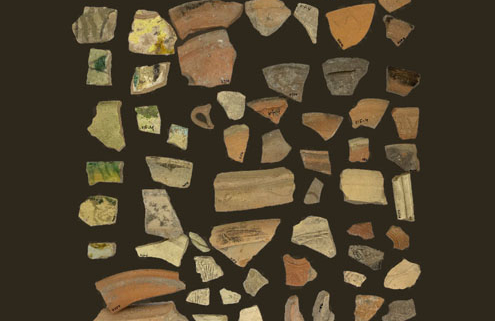
Roughly 21% of the pottery dates to the Early Islamic Period (ca. 638-1099 CE). Bowls, jugs, oil lamps and cooking vessels dominate the assemblage, while other forms comprise a minor fraction of it. Although during the early stages of the period certain vessel types continue the traditions of the previous period, many new forms appear as well, and potters introduce new manufacturing methods as well as clay fabrics. One such example, the well-known “buff ware” vessels initially appear during the early Abbasid Period (second half of the 8th century CE). These vessels are composed of light-colored clay and are often adorned with incised and impressed decorations. An additional innovation introduced during the period is the use of glazing techniques. Indeed, several different glazing methods and styles appearing primarily on open vessels are an integral part of this assemblage.
Some types characteristic of the end phases of the previous Byzantine Period continue to appear during this time as well. Most notable among these are bowls belonging to the ‘’Fine Byzantine Ware’’ group. Some of these bowls are adorned with a new style of decoration in which various painted designs were applied to a white background. During this time, as previously stated, certain new types which continue in development from types belonging to the previous period make their first appearance. These vessels, known as ‘’Fine Burnished Ware’’ are characterized by somewhat different forms and fabrics than their predecessors. They are composed of clay of inferior sorting quality; their lower extremities are often coated with a white colored wash and the circular burnishing is typically applied to the lower section of the vessel.
While initially the ‘’Candle Stick’’ oil lamp, common in the previous Byzantine assemblages continues to appear during the early phases of the Early Islamic Period, a new lamp known as the ‘’Channel-Nozzle Oil Lamp’’ makes its debut during the Umayyad Dynasty’s time (7th – early 8th centuries CE).
Glazed vessels, likewise, make their first appearance during the Umayyad Period and become widespread during the subsequent Abbasid Period. During the 9th-10th centuries, the technique of ‘’splashed and mottled’’ glaze was introduced in addition to Sgraffito, a decorative method of applying two layers of contrasting slip or glaze and then finely scraping in order to expose parts of the underlying layer. During the Abbasid Period (8th-11th centuries CE), a tin glaze was often applied, creating a white porcelain-like surface. Lustrous metallic-like glazes occasionally appeared as well. While most of the vessels during this period were locally produced; some of the more elaborate glazed wares such as the tin glazed lustrous wares were clearly imported.
Discover more from The Temple Mount Sifting Project
Subscribe to get the latest posts sent to your email.




